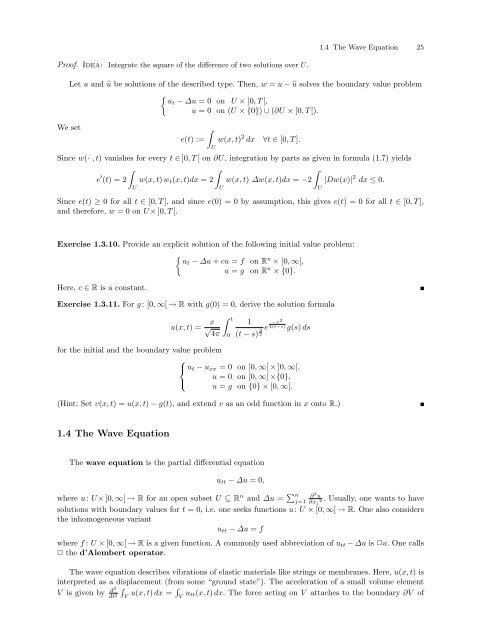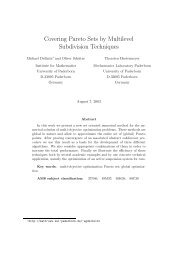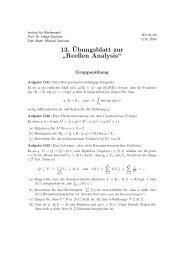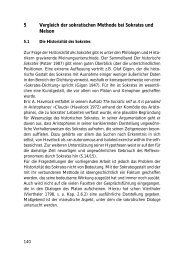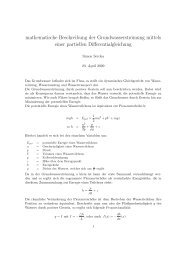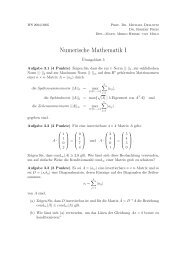Partial Differential Equations
Partial Differential Equations
Partial Differential Equations
Create successful ePaper yourself
Turn your PDF publications into a flip-book with our unique Google optimized e-Paper software.
1.4 The Wave Equation 25<br />
Proof. Idea: Integrate the square of the difference of two solutions over U.<br />
We set<br />
Let u and ũ be solutions of the described type. Then, w = u − ũ solves the boundary value problem<br />
{<br />
ut − ∆u = 0 on U × ]0, T [,<br />
u = 0 on (U × {0}) ∪ (∂U × [0, T [).<br />
∫<br />
e(t) :=<br />
U<br />
w(x, t) 2 dx ∀t ∈ [0, T ].<br />
Since w(· , t) vanishes for every t ∈ ]0, T [ on ∂U, integration by parts as given in formula (1.7) yields<br />
∫<br />
∫<br />
∫<br />
e ′ (t) = 2 w(x, t) w t (x, t)dx = 2 w(x, t) ∆w(x, t)dx = −2 |Dw(x)| 2 dx ≤ 0.<br />
U<br />
U<br />
Since e(t) ≥ 0 for all t ∈ [0, T ], and since e(0) = 0 by assumption, this gives e(t) = 0 for all t ∈ [0, T ],<br />
and therefore, w = 0 on U× ]0, T [.<br />
U<br />
Exercise 1.3.10. Provide an explicit solution of the following initial value problem:<br />
{<br />
ut − ∆u + cu = f on R n × ]0, ∞[,<br />
u = g on R n × {0}.<br />
Here, c ∈ R is a constant.<br />
Exercise 1.3.11. For g : [0, ∞[ → R with g(0) = 0, derive the solution formula<br />
u(x, t) =<br />
√ x ∫ t<br />
4π<br />
0<br />
1<br />
(t − s) 3 2<br />
e −x2<br />
4(t−s) g(s) ds<br />
for the initial and the boundary value problem<br />
⎧<br />
⎨ u t − u xx = 0 on [0, ∞[ × ]0, ∞[,<br />
u = 0 on [0, ∞[ ×{0},<br />
⎩<br />
u = g on {0} × [0, ∞[.<br />
(Hint: Set v(x, t) = u(x, t) − g(t), and extend v as an odd function in x onto R.)<br />
1.4 The Wave Equation<br />
The wave equation is the partial differential equation<br />
u tt − ∆u = 0,<br />
where u: U× ]0, ∞[ → R for an open subset U ⊆ R n and ∆u = ∑ n<br />
j=1 ∂2 u<br />
∂x j<br />
2 . Usually, one wants to have<br />
solutions with boundary values for t = 0, i.e. one seeks functions u: U × [0, ∞[ → R. One also considers<br />
the inhomogeneous variant<br />
u tt − ∆u = f<br />
where f : U × [0, ∞[ → R is a given function. A commonly used abbreviation of u tt − ∆u is ✷u. One calls<br />
✷ the d’Alembert operator.<br />
The wave equation describes vibrations of elastic materials like strings or membranes. Here, u(x, t) is<br />
interpreted as a displacement (from some “ground state”). The acceleration of a small volume element<br />
V is given by d2<br />
dt 2 ∫V u(x, t) dx = ∫ V u tt(x, t) dx. The force acting on V attaches to the boundary ∂V of


